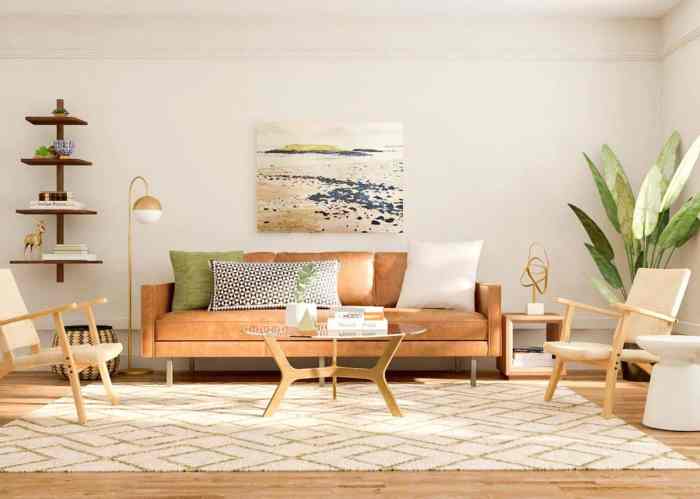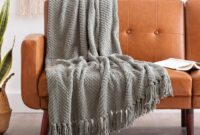Mid-century modern furniture and décor take center stage in this insightful exploration of design elements and historical significance, offering readers a glimpse into the world of iconic style and sophistication.
Delve into the essence of mid-century modern pieces and discover the key features that define this classic aesthetic.
Overview of Mid-century Modern Furniture and Décor

Mid-century modern furniture is characterized by clean lines, organic forms, and a minimalist approach to design. This style emerged in the mid-20th century and has remained popular ever since for its timeless appeal.
Characteristics of Mid-century Modern Furniture
- Sleek and simple designs
- Use of natural materials like wood, metal, and leather
- Integration of form and function
- Geometric shapes and clean lines
- Emphasis on comfort and practicality
Design Principles of Mid-century Modern Décor
Mid-century modern décor is based on the following design principles:
- Functionality: Furniture should be practical and serve a purpose.
- Simplicity: Clean lines and minimal ornamentation are key.
- Form follows function: Design elements should complement the overall function of the space.
- Natural elements: Incorporating natural materials like wood and stone adds warmth and texture.
- Open spaces: Mid-century modern design often features open floor plans and uncluttered spaces.
Historical Context of Mid-century Modern Style
The mid-century modern style emerged in the post-World War II era, influenced by a desire for simplicity, functionality, and a connection to nature. Designers like Charles and Ray Eames, Eero Saarinen, and George Nelson played a significant role in shaping this aesthetic, which continues to be celebrated for its innovative approach to design.
Key Features of Mid-century Modern Furniture

Mid-century modern furniture is characterized by a unique blend of functionality, simplicity, and elegance. The use of innovative materials and design techniques sets it apart from other styles.
Common Materials Used in Mid-century Modern Furniture
Mid-century modern furniture often incorporates a variety of materials to achieve its distinctive look. Some common materials used include:
- Teak: Known for its durability and warm tones, teak wood is a popular choice for mid-century modern furniture.
- Walnut: Walnut wood is another favorite due to its rich, dark color and natural grain patterns.
- Metal: Steel and chrome are frequently used in mid-century modern furniture to add a sleek and modern touch.
- Plastic: Molded plastic was also a common material in mid-century modern design, contributing to the futuristic aesthetic of the era.
Typical Color Palette of Mid-century Modern Pieces
The color palette of mid-century modern furniture is often characterized by a mix of bold, vibrant hues and more subdued, earthy tones. Some typical colors used in mid-century modern pieces include:
- Mustard yellow
- Olive green
- Turquoise
- Orange
- Midnight blue
- Neutral shades like white, black, and brown
Clean Lines and Organic Shapes in Mid-century Modern Design, Mid-century modern furniture and décor
Mid-century modern furniture is known for its clean lines and organic shapes that emphasize simplicity and functionality. These design elements create a sense of openness and lightness in the space, making mid-century modern pieces versatile and timeless.
Popular Mid-century Modern Furniture Pieces: Mid-century Modern Furniture And Décor
Mid-century modern furniture is known for its iconic pieces that have stood the test of time in terms of style and functionality. These pieces are not only visually appealing but also highly versatile, making them a popular choice for interior design enthusiasts.
Eames Lounge Chair and Ottoman
The Eames Lounge Chair and Ottoman, designed by Charles and Ray Eames in 1956, is one of the most iconic pieces of mid-century modern furniture. It is renowned for its sleek and ergonomic design, featuring a molded plywood shell and leather upholstery. This chair perfectly embodies the mid-century modern aesthetic of form meeting function.
Saarinen Tulip Table
The Saarinen Tulip Table, designed by Eero Saarinen in 1956, is another classic piece of mid-century modern furniture. Its pedestal base and smooth, rounded top create a minimalist yet elegant look that fits seamlessly into various design styles. The table’s timeless design makes it a versatile choice for both residential and commercial spaces.
Wegner Wishbone Chair
The Wegner Wishbone Chair, designed by Hans J. Wegner in 1949, is a Danish classic that has become synonymous with mid-century modern style. With its distinctive Y-shaped backrest and woven seat, this chair exudes a sense of craftsmanship and sophistication. The Wishbone Chair is a perfect example of how mid-century modern furniture combines form and function effortlessly.
George Nelson Marshmallow Sofa
The George Nelson Marshmallow Sofa, designed by George Nelson in 1956, is a playful and innovative piece that challenges traditional sofa design. With its unique circular cushions supported by a slender metal frame, this sofa adds a whimsical touch to any space. The Marshmallow Sofa showcases the creativity and ingenuity that defined the mid-century modern era.
Incorporating Mid-century Modern Décor into Interior Design

Mid-century modern décor can add a touch of retro charm and sophistication to any space. When mixing mid-century modern pieces with contemporary furniture, it’s essential to strike a balance between the two styles to create a cohesive look. Here are some tips on how to successfully incorporate mid-century modern décor into your interior design:
Mixing Mid-century Modern Pieces with Contemporary Furniture
When mixing mid-century modern pieces with contemporary furniture, consider the following:
- Focus on complementary colors and materials to tie the different styles together.
- Use mid-century modern accent pieces like chairs, lighting fixtures, or side tables to add a retro flair to a contemporary space.
- Experiment with textures and patterns to create visual interest and contrast between the two styles.
Creating a Cohesive Mid-century Modern Look in a Room
To create a cohesive mid-century modern look in a room, follow these suggestions:
- Choose a few key mid-century modern pieces as focal points and build the room’s design around them.
- Opt for clean lines, organic shapes, and minimalist designs typical of mid-century modern furniture.
- Incorporate vintage or retro accessories like artwork, rugs, or decorative objects to enhance the overall mid-century modern aesthetic.
Importance of Balance and Proportion
Balance and proportion are crucial when incorporating mid-century modern décor into interior design:
- Ensure the scale of mid-century modern pieces complements the size of contemporary furniture for a harmonious look.
- Avoid overcrowding a space with too many mid-century modern items, as it can overwhelm the room and disrupt the balance.
- Pay attention to the placement of furniture and accessories to maintain a sense of proportion and visual balance in the room.
In conclusion, the allure of mid-century modern furniture and décor lies in its ability to seamlessly blend functionality with timeless beauty, making it a must-have for any design enthusiast looking to infuse their space with a touch of sophistication.
When it comes to protecting your home in disaster-prone areas, having the right insurance coverage is crucial. This comprehensive guide on insuring homes in disaster-prone areas can help you understand the options available to safeguard your property.
For homeowners with valuable art collections, ensuring that your investments are protected is essential. Learn more about the coverage options available for homes with expensive art collections in this guide on protecting your treasured investments.
Curious if your homeowners insurance covers your home security system? Find out the answer to this question and more in this informative guide on home security systems. Protecting your home and loved ones has never been easier.




